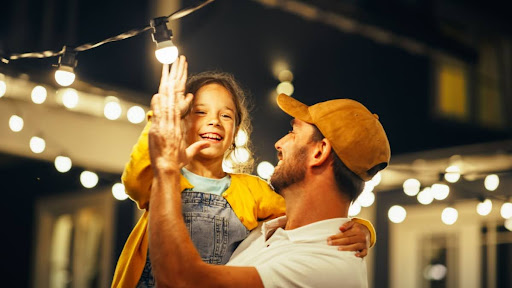When the sun sets and night takes over, we rely on outdoor lighting to brighten our homes, guide our steps, and make us feel secure. There’s something welcoming about the glow of a porch light or the sparkle of string lights over a patio, making our outdoor spaces feel cozy and inviting. Beyond aesthetics, outdoor lighting is vital for safety — it helps to prevent accidents, deters potential burglars, and highlights features around the property.
However, outdoor lighting can bring its own risks if not set up or maintained correctly. Electrical issues, poor wiring, and even the wrong bulb choices can lead to problems like electrical fires, energy drains, and broken fixtures. That’s why every homeowner should know the dos and don’ts of outdoor lighting safety. With a few smart choices, you can enjoy the best of both worlds: a beautiful, secure outdoor lighting setup that makes your home stand out while avoiding unnecessary risks.
Are you ready to learn how to get your outdoor lighting just right? Let’s review the essentials of how to do outdoor lighting safely.
Why Is Outdoor Lighting Safety Important?
Outdoor lighting isn’t just about aesthetics or creating a welcoming front porch. It’s an important part of home security, accident prevention, and energy management. For example, a well-lit exterior can help deter burglars, making your home feel safer. Properly placed outdoor lights can also reduce the risk of tripping hazards or prevent accidents around dark areas. However, even minor mistakes — like using the wrong light bulbs or poor wiring — can lead to bigger issues, such as electrical fires or unexpected energy costs.
Outdoor lighting safety is about knowing how to do outdoor lighting right from the start. Here’s a closer look at the dos and don’ts of getting it just right.
Dos of Outdoor Lighting Safety
It’s time to dive into the dos and don’ts of outdoor lighting safety. Let’s start with the steps that can help you keep your outdoor lighting system secure, effective, and long-lasting.
Do Use Outdoor-Rated Fixtures and Bulbs
Outdoor lighting requires fixtures and bulbs that can withstand weather changes, moisture, and exposure to the elements. Always choose outdoor lighting fixtures and bulbs specifically rated for exterior use. LED bulbs are a fantastic choice because they emit less heat and save energy, which means lower energy bills and less risk of overheating or fire.
Do Install Ground Fault Circuit Interrupters (GFCIs)
GFCIs are a must for any electrical setup near water, making them essential for outdoor lighting. These outlets automatically shut off power if they detect an electrical issue, helping to prevent shocks and reduce the chance of electrical fires. Any outdoor lighting fixtures near water — such as around pools, hot tubs, or even garden hoses — should be plugged into GFCI-protected outlets.
Do Regularly Inspect Your Lighting Fixtures
Outdoor lights are exposed to dirt, dust, moisture, and other elements that can cause wear over time. Regularly cleaning and checking your lighting fixtures can prevent potential issues before they start. Look for loose wires, cracked bulbs, or other damage that could lead to water infiltration or short circuits. Make it a habit to change out old or dimming bulbs before they burn out.
Do Use Motion Sensors for Security Lighting
Motion sensors add an extra layer of security without requiring you to keep lights on all night. They’re especially effective for security lighting in darker areas like side yards or back entrances. Motion-activated lights not only save energy but also act as a deterrent by shining a bright light on potential burglars.
Do Plan Lighting Placement Thoughtfully
A good outdoor lighting setup is both safe and visually appealing. Place lights along pathways, steps, and near entrances to illuminate dark spots and prevent accidents. Floodlights are useful for high-traffic areas, like driveways, while string lights add a soft glow to seating areas. Take the time to plan your layout so your lighting is both functional and attractive.
Don’ts of Outdoor Lighting Safety
Now that we’ve covered the must-dos, let’s explore some common mistakes that could make your outdoor lighting setup unsafe.
Don’t Overload Circuits
When discussing the dos and don’ts of outdoor lighting safety, we have to mention the dangers of overloaded circuits. An overloaded circuit can quickly lead to electrical issues. Avoid plugging too many lighting fixtures into a single outlet, and check that bulb wattages match your fixture’s rating. Overloading circuits can cause overheating and power outages, increasing the risk of electrical fires. When in doubt, consult a licensed electrician to extend your setup safely.
Don’t Use Indoor Fixtures Outdoors
Using indoor fixtures outside can be dangerous. Indoor lights aren’t made to withstand moisture, temperature fluctuations, or direct exposure to the elements, which can lead to cracked fixtures, short circuits, or worse. Stick to fixtures specifically rated for outdoor use to keep your lighting system safe from weather-related hazards.
Don’t Ignore Wiring Safety
Exposed or poorly installed wiring is a common cause of electrical fires. If you’re installing lights yourself, make sure to use waterproof connectors and cover any visible wires to keep them protected from moisture. Consider hiring a professional for a worry-free setup that prioritizes lighting safety and reliability.
Don’t Place Lighting Near Flammable Materials
When setting up lights near wood, dry leaves, or other flammable materials, be extra cautious. Heat-producing bulbs and improperly placed fixtures can pose fire risks. LED bulbs are generally safer since they emit less heat, but it’s always wise to keep a safe distance between lights and combustible materials.
Don’t Forget to Test and Adjust Your Setup
Testing your lights once installed is essential for both visibility and safety. Check each light to verify that it’s providing adequate brightness and covering the intended area without creating glare. Adjust brightness or reposition lights to keep your property well-lit without disturbing neighbors or affecting visibility in unwanted ways.
Schedule Outdoor Lighting Services With Grasser Electric!
By following the dos and don’ts of outdoor lighting safety — like using outdoor-rated fixtures, installing GFCIs, checking wiring, and placing lights strategically — you can enjoy a safer outdoor space.
Keeping your outdoor lighting both beautiful and safe doesn’t have to be complicated, especially when you work with a professional. The experts at Grasser Electric can help you set up an outdoor lighting system that looks great and functions flawlessly. With years of experience in interior and outdoor lighting in St. Louis and the nearby areas in St. Charles County, Grasser Electric offers the expertise to handle any lighting project.
Don’t leave your outdoor lighting safety to chance. Contact us today to schedule your residential electrical services in St. Louis, St. Charles, or one of the surrounding areas!

